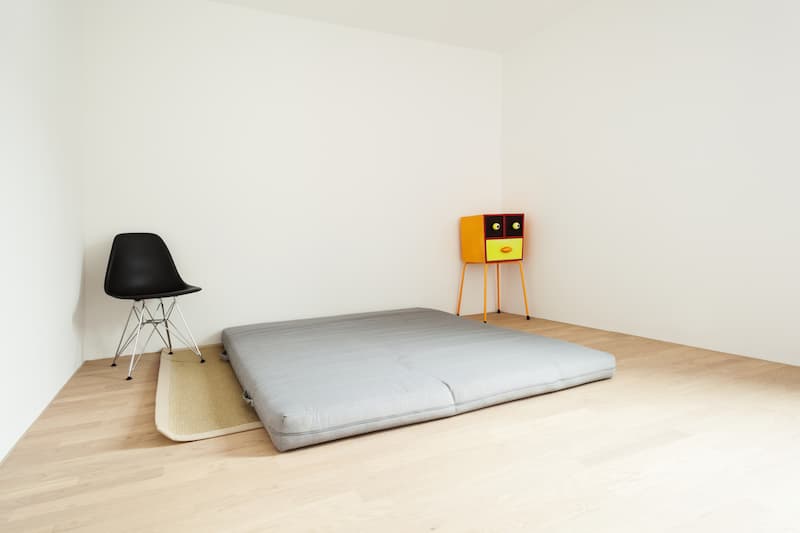Can I put a memory foam mattress on the floor?
There are some strong arguments in favour of leaving your mattress on the floor permanently. Why would you need a bed frame when you can simply leave your mattress lying flat and comfortably on the most extensive support base there is – the floor?

After all, it’s common in several cultures worldwide, and they are doing just fine. Besides its postural benefits, some have lauded its ability to keep a mattress firm for a long time.
While this is true, it is also essential to consider how a memory foam mattress will fare if left on the floor for an extended period.
This article looks into these possible effects of floor-mounting your memory foam. And from there, conclude whether to put your memory mattress on the floor permanently.
Five Primary Considerations Before Putting Your Memory Mattress on the Ground
While putting your mattress on the floor might have its advantages, it has its cons.
Here are some possible effects of putting your mattress on the floor that you should consider.
Mattress Damage
Memory mattresses are made up of various layers of materials. The goal is for all of them to work in tandem to relieve pressure on specific areas of your body. Leaving your memory foam mattress on the floor damages some softer laters, causing indentation.
The longer it sits on the floor, the more damage the foam layers sustain.
Memory mattresses are susceptible to dents and scuffs even with a proper frame.
However, this process speeds up when the mattress is placed on the floor. This is because, unlike on a bed frame, where proper, gentle compression is achieved in the softer transition layers, the comfort layers are crushed faster.
Mold and Insect Infestations
Memory foam on the floor is vulnerable to heat and moisture trapped between the mattress and the tight-contact floor.
This provides the perfect breeding ground for molds and bed bugs.
You also know that creeping arachnids and insects also need someplace to rest. A memory mattress lying freely on the floor brings them closer to that. These insects crawling onto your mattress will ruin your otherwise perfect evening of sleep.
Respiratory and Dust Allergies
Sleeping on the floor with a memory foam mattress can aggravate allergy symptoms because moisture builds up and airflow is restricted under the mattress.
Memory foam mattresses have high-density foam foundations, which easily restrict airflow and trap moisture and dust. With a mattress placed on the ground, this task is made more accessible by the cooler air near the floor. This provides the perfect environment for growing dust, pollen, and other allergens.
Pain
While many would contend that laying your mattress on the ground firms it up and reduces back pain, memory mattresses from the right company are already designed to be firm enough. Placing it on the floor only makes it firmer. This puts more pressure on your body, especially your shoulders and hips.
Since memory mattresses are designed to relieve pressure points, placing them on the floor changes how they interact with your body.
This could cause discomfort in those spots as well as the lower back.
Something worth noting is that placing your mattress on the floor forces you into an uncomfortable rising posture after a night’s sleep. It puts more strain on your lower back. Continually stressing your back structures predisposes you to lower back pain if it continues for a long time.
Temperature Changes
Memory foams are notorious heat trappers, valid for cold and hot air.
While it’s generally true that altitude results in a drop in temperature, the opposite is valid in your bedroom. How this affects you depends on the current climate where you live.
Having your memory foam mattress lying on the floor during the winter is like asking for a chill. You would feel colder on the floor, and your memory mattress would attract more cold and transfer it to you.
On the other hand, having your memory foam on the floor for a while during the summer and in cities closer to the equator might not be a bad idea.
Read how to store the memory foam mattress
Bottom Line
Memory mattresses were not designed to be placed on floors, at least not for an extended period. When placed on the ground, memory foam readily absorbs air and moisture. That’s the perfect environment for mold to grow and spread, eventually ruining your mattress.
Read if memory foam mattress wear out or not
On top of that, putting a memory foam mattress on the floor makes it firmer on your body, negating the mattress’s point and alleviating pressure points.
However, this isn’t written in stone. Putting your memory mattress on the floor for a couple of nights is not a bad idea if you need to correct your posture and increase blood flow.
